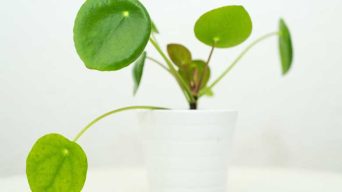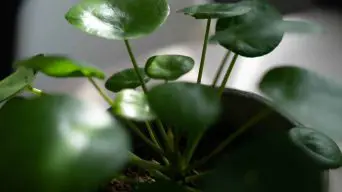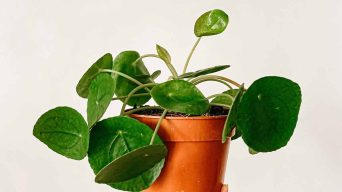Key Takeaways
- Growing Pilea plants in water offer numerous benefits, such as reduced risk of root rot and better access to oxygen for healthier growth.
- To grow your Pilea plant in water, select a glass container with a narrow opening and prepare a cutting from a healthy mother plant.
- Maintain consistent water levels and temperature, provide proper lighting and fertilization, regularly prune and propagate the plant, and be aware of common problems to ensure successful growth.
- Common mistakes to avoid when growing Pilea plants in water include using tap water without treatment, neglecting to change the water regularly, overcrowding the container, and overfeeding the plant.
Are you looking to grow Pilea plants with ease and minimal mess? Look no further!
In this guide, we’ll unveil the simple yet effective method of growing these popular houseplants in water.
You’ll discover numerous benefits of going soil-free, learn step-by-step how to propagate and maintain your Pileas in water and receive valuable tips that lead to successful growth.
Benefits Of Growing Pilea Plants In Water
Growing Pilea plants in water offer numerous advantages over traditional potting mix-based methods, making it an attractive option for plant owners.
One significant benefit is that root rot and decay risk are substantially reduced since there’s no soil to harbor harmful fungi or bacteria.
Another advantage of growing your Pilea plants in water is that the roots have better access to oxygen than when grown in soil, thanks to their thinner structure.
This promotes healthy growth and enables your Pilea plant to absorb nutrients from the water more efficiently.
Lastly, growing Pilea plants in water provides a visually captivating display due to their unique foliage and intriguing root system visible through a transparent container.
Step-by-Step Guide To Growing Pilea Plants In Water
We will guide you through the process of growing Pilea plants in water with detailed step-by-step instructions.
Following these guidelines allows you to propagate and care for your Chinese Money Plant easily.
Choosing The Right Container
Selecting the ideal container for growing your Pilea plant in water is crucial to ensuring its success and overall health.
Pay attention to both size and material when making a decision.
Opt for glass containers whenever possible, as their aesthetic appeal complements the vibrant green foliage of your Pilea plant beautifully.
Furthermore, these transparent containers allow you to easily monitor the plant’s roots without disturbing them.
Choose a container with a narrow opening to support and keep the Pilea upright throughout its growth process.
Make sure that the size of your selected container corresponds well with your Pilea’s current size and potential root system expansion – not too small or restricting, yet not excessively large, as it may slow down growth due to excessive moisture retention in unused portions of soil mixtures within larger pots.
Preparing The Cutting
Select a healthy mother plant with sturdy stems and lush leaves to prepare a Pilea cutting.
Use clean, sharp scissors or pruning shears to snip off a stem with at least two nodes (the points where leaves grow) and some foliage.
This will provide the new plantlet with ample energy for rooting and growth.
Once you have your cutting, gently remove any leaves from the lower part of the stem that would be submerged in water during propagation.
Submerging these parts may cause decay or rot, which could hinder successful growth in water.
As an optional step before placing it into the water, you can dip the end of your cutting in rooting hormone powder to encourage faster root development; however, Pilea plants tend to root quite easily without it.
Adding Water And Nutrients
To add water and nutrients to your Pilea plant, fill the container with clean, room temperature water.
You can use tap water but ensure it has been allowed to sit for 24 hours before using it, which allows chlorine and other chemicals to dissipate.
It’s important not to overwater Pilea plants in water since they are sensitive to excess moisture.
Check the water level frequently and top up as needed, but avoid letting the plant sit in standing water.
Replacing the water every month is crucial when growing Pileas in containers without drainage holes since stagnant water can lead to root rot.
Monitoring And Maintaining
Ensuring that your Pilea plants thrive in water requires consistent monitoring and maintenance.
It is important to replace the water in your container every month or when it appears cloudy or dirty.
Clean the inside of the vessel with soap and warm water before adding fresh, room temperature water.
To prevent root issues from occurring, maintain consistent water levels and temperatures for your Pilea plants, especially during colder seasons.
Regularly check the moisture content of the soil mix and adjust the watering frequency as needed based on weather conditions and growth stages.
Tips And Tricks For Successful Growth
To ensure the successful growth of your Pilea plants in water, it is important to maintain consistent water levels and temperature, provide proper lighting and fertilization, regularly prune and propagate the plant, and be aware of common problems.
Consistent Water Level And Temperature
Pilea plants are known for their love of consistent water levels and temperatures.
Maintaining the water level in your container is important so that the roots remain hydrated and healthy.
The ideal temperature range for Pileas is between 60-85 degrees Fahrenheit, keeping them away from direct sunlight or drafts.
If you’re growing Pilea plants indoors, placing them near a window with indirect light should be enough to meet their lighting needs while ensuring they don’t overheat.
Remember that temperature changes can lead to stress on the plant, so try to keep it as stable as possible.
Proper Lighting And Fertilization
Proper lighting is crucial for the successful growth of Pilea plants in water.
While they cannot tolerate direct sunlight, Pilea plants thrive in bright, indirect light.
It’s best to place them in an area of your home that receives plenty of filtered light throughout the day.
Fertilization is also essential for healthy Pilea plant growth.
A balanced, water-soluble fertilizer can be added to the water once a month during the growing season (spring and summer).
Be sure not to over-fertilize your plant, which can lead to excess salt buildup and damage to its roots.
Regular Pruning And Propagation
Regular pruning is crucial for the healthy growth of your Pilea plants.
Trimming back the stem and foliage helps maintain a pleasing shape, encourages new growth, and prevents overcrowding in the pot.
You can use sharp scissors or pruning shears to make clean cuts above a leaf node.
Propagation is an excellent way to expand your collection of Pilea plants without spending more money on additional plants.
Stem cuttings or single leaves can be propagated easily by placing them in water until roots form, which usually takes about two weeks.
Common Problems And How To Avoid Them
One common issue when growing Pilea plants in water is the development of root rot.
This can occur if the Pilea plant is overwatered or the water sits stagnant for too long, allowing harmful bacteria to grow in the roots.
Do not overcrowd your container; provide proper drainage to avoid this problem.
Another common problem with Pilea plants grown in water is under-watering.
Symptoms of under-watering include stunted new growth, yellow or brown leaves, and a loss of lower foliage.
To prevent this from happening, give your plant frequent watering when needed and maintain consistent moisture levels without overdoing it.
By following these simple tips and looking for signs of trouble like wilting stems or discoloration on leaves, you can successfully grow beautiful Pilea plants in the water year-round!
Always be mindful of watering schedules and other factors influencing their health, such as temperature fluctuations or humidity levels within your home environment.
Common Mistakes To Avoid When Growing Pilea Plants In Water
To ensure healthy growth for your Pilea plants in water, avoiding some common mistakes is important.
These include using tap water without proper treatment, neglecting to change the water, overcrowding the container, and overfeeding the plant.
By avoiding these mistakes, you can help your plants thrive.
Using Tap Water Without Proper Treatment
Using tap water without proper treatment is a common mistake that can lead to problems when growing Pilea plants in water.
Tap water contains chemicals like chlorine and fluoride, harming the plant’s delicate roots and hindering its growth.
If you don’t have access to filtered or distilled water, you can treat your tap water by letting it sit out overnight.
This will allow the chlorine to evaporate, making the water safer for your plant.
A good quality liquid fertilizer can provide essential nutrients for healthy growth.
Neglecting To Change The Water
One common mistake to avoid when growing pilea plants in water is neglecting to change the water.
Stagnant water can lead to an accumulation of harmful bacteria, which can cause root rot and ultimately result in the death of your plant.
Changing the water every two weeks or so is important to ensure your plant stays healthy.
In addition, when changing the water, clean the container thoroughly with soap and warm water before refilling it with fresh water.
This will help prevent any lingering bacteria from infecting your plant.
Overcrowding The Container
One common mistake to avoid when growing Pilea plants in water is overcrowding the container.
While grouping several cuttings in one vase may be tempting, this can hinder their growth and lead to problems like root rot and decay.
To ensure optimal growth, ensure each cutting has enough space for its roots to spread out and breathe.
If you want multiple Pilea plants in one container, choose a larger vase or separate them into individual vessels once they have established roots.
Overfeeding The Plant
Another common mistake to avoid when growing Pilea plants in water is overfeeding them with nutrients.
While providing the plant with extra nutrients may seem reasonable, doing so can harm its growth and even lead to eventual death.
To avoid overfeeding your Pilea plants in water, be sure to use the recommended amount of fertilizer and adhere strictly to the schedule for application.
Before adding any fertilizer, ensure you understand how much of each nutrient your plant needs based on size and age.
It’s also essential to closely monitor your plants’ growth for signs of nutrient deficiency or toxicity caused by overfeeding.
Final Thoughts
Growing Pilea plants in water is a fun and easy way to propagate this popular plant.
Following our step-by-step guide, you can successfully grow healthy Pilea plants in water with proper care, monitoring, and maintenance.
Remember to choose the right container, add nutrients, change the water regularly, and maintain consistent temperature and humidity levels.
Avoid common mistakes like overfeeding or neglecting to change the water that can lead to plant death or decay.







